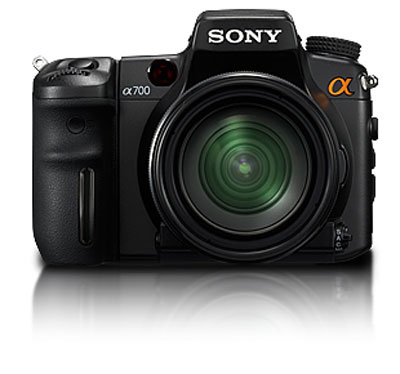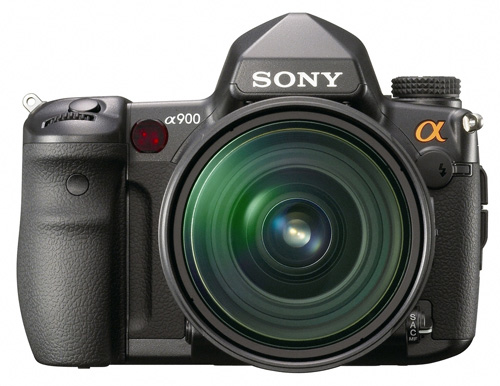Sony A900 Full-Frame: Hands-On Preview
by Wesley Fink on September 12, 2008 12:00 AM EST- Posted in
- Digital Camera
When Sony purchased Konica-Minolta in January of 2006, everyone expected the world's largest digital sensor manufacturer to use the Minolta acquisition to boomerang Sony's entry into the DSLR market. It was soon clear that Sony had ambitious plans for capturing market share in photography's fastest growing market, but the going has been slow.

In the past year Sony has kicked up the pace, beginning with the A700 to compete in prosumer space, followed quickly by the A200 entry-level DSLR, and the A350/A300 DSLRs built with a truly unique and useful Sony implementation of Live View. The Sony Live View is the only Live View that truly behaves like a point and shoot camera in Live View mode. It's as simple as a switch that lets a new user move between Live View and traditional DSLR.
The culmination of the Sony push into the Digital SLR market was unveiled on September 8, after 18 months of hints, speculation, and closed case exhibits at photography events. It is likely that anyone out there who follows photography has at least heard of the A900 - Sony's flagship DSLR and the first to showcase the new Sony 24.6MP full-frame sensor. It also gives the full-frame resolution crown to Sony for the time being, as no other full-frame sensor can claim resolution this high. The closest competitor is the $8000 Canon 1Ds Mark III at 21.1MP.

Sony launched the new A900 in events around the world where invited press and professional photographers were given the opportunity for hands-on time with the A900. It was certainly a controlled environment, with a studio setup with a model and a typical tethered studio shooting product ads. The two environments do reflect how most photographers make their living today, but the manufacturer setups are hardly designed for a competitive comparison. That will have to wait until production cameras arrive in November.
Today we are publishing the A900/Sony DSLR press announcements. You may have already seen the A900 announcement, but we have gathered information on the Sony flagship items together so you can more easily see how the parts contribute to the whole. There was not enough hands-on time to do anything like a thorough analysis of a groundbreaking new camera like the A900. That will have to wait until the release of the A900 in November. However, strong impressions were triggered and we did have enough time with the A900 system to answer many of our questions about the feel, layout, and controls of the new A900. Those impressions are shared on pages seven and eight in our complaints and praise for the new Sony A900.










53 Comments
View All Comments
sprockkets - Saturday, September 13, 2008 - link
Flash that Makes L Brackets Obsolete - Fortunes have been made with L brackets for pro cameras that enable shooting flash vertical with the flash also rotated 90 degrees. When you see the new Sony HVL-F58AM flash, you'll wonder why Sony - or you, or anyone else - didn't think of it sooner. The flash head turns smoothly in a 90 degree arc as one of its movements - aligning the flash perfectly for portrait mode. Goodbye L bracket.Sorry, quote funtion wouldn't work. Why is this an issue? Flashes for the longest time do something really easy to bounce or flash vertically in portrait mode. It's called they rotate horizontally. The only advantage here I suppose is that the back display is now easier to read facing up. Am I missing something here?
Maxington - Monday, September 15, 2008 - link
I was wondering the same thing about the Sony flash, exactly what is so special about it?I can do ceiling bounce flash holding the camera in portrait with my Pentax 540 flash, and that's been out for years.
What is this Sony flash doing that has everyone so excited?
randomlinh - Sunday, September 14, 2008 - link
I was thinking the same... this moves the flash a little closer in line with the lens.. but l brackets still have one huge advantage... it RAISES the flash up, which can be quite beneficial in itself.Crafty Spiker - Saturday, September 13, 2008 - link
Regardless of the product - do you really want to "vote" for Sony?melgross - Friday, September 12, 2008 - link
It's interesting that both Canon's 5D, and Nikon's D700 cameras are considered to be, even by their manufacturers, advanced amateur or semi-pro bodies, but at the same price level, the Sony 900 is considered to be professional, ala the Canon 1Ds, 1D, and Nikon D3.Sorry, this camera isn't built like those pro bodies from Canon and Nikon.
While pro's certainly use the 5D, and D700, they also use the 40D and the D300.
So, are those now pro bodies as well?
Sensor size doesn't determine whether a body is pro, and really, neither does weather sealing.
The 1Ds 1D, and D3 are certainly the most rugged bodies on the market, nothing else approaches them in this.
chiew - Sunday, September 14, 2008 - link
Sony has no weather sealed lenses...I doubt pros who shoot in adverse conditions will want a Sony until it is proven.Wesley Fink - Saturday, September 13, 2008 - link
The Canon 5D and Nikon D700 have 95% wiewfinders. So do the D300 and 40D. The Nikon D3, Canon 1Ds MkIII, AND Sony A900 all have 100% viewfinders. That is certainly one measure of a Pro camera.In comparing the build quality of the A900 to my D3 I did not find the A900 lacking. Of course the test of time is what matters most in evaluating build quality and it will take a while to see if the build is as rugged as it appears.
I assumed the grip would be an Achilles heel since the other Pro models have a built-in grip. However, the A900 grip uses the same magnesium alloy shell and sealing used on the a900. Still, an integrated grip would certainly be better sealed almost by definition. Frankly I prefer a grip I can leave at home if I choose. The true Pro models that fit your criteria are all a pain to lug around in the field. That's why my D4 stays at home sometimes and the D700 goes with me.
In the end I have no doubt the Sony is as well constructed as the other cameras you judge as Pro. I do, however, have reservations about a shutter that is only rated for 100,000 actuations. That is very low for a camera to be considered Pro, and is much more typical of semi-Pro or Advanced prosumer models.
melgross - Wednesday, September 17, 2008 - link
Big deal. Over the years, the Nikon F series had a 100% viewfinder. That didn't prevent Canon from knocking it off it;s top spot, even though Canon didn't consider that to be important.In fact, for many years, a 100% viewfinder was considered to be a negative. When we shot transparencies, the mount covered the millimeter around the outside edge of the slide, making what you saw no more than about 96% of the total. Using a 100% viewfinder often caused the mount to hide the edge of what you saw anyway.
Nowadays, it;s true, that doesn't matter, but 2 to 5% of the viewfinders outside edges is of no real noticeable importance if its less than the full frame. The problem would be the other way around.
I think the shutter is far more important in telling us what this camera is intended for than whatever else we can see from the outside. Can't judge a camera by its shell. Even the 5D II now has a 150,000 cycle shutter.
Lord 666 - Saturday, September 13, 2008 - link
The D300 has a 100% viewfinder. However, at $3000 for the D700, they could have easily used the same from D3... but more than likely did not to protect sales of D3.http://www.nikonusa.com/Find-Your-Nikon/Product/Di...">http://www.nikonusa.com/Find-Your-Nikon/Product/Di...
Wesley Fink - Saturday, September 13, 2008 - link
You are correct, the D300 does have a 100% finder. Mea Culpa.